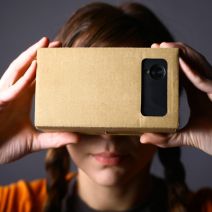SMART Blog
4 Virtual Reality Technologies Poised to Shake Up the Market
 Entertainment has grown so synonymous with smartphones and technology that it’s almost impossible to think about these innovations without considering their entertainment value. Virtual reality augmentation, while slightly different, is an emerging technology that brings elements of virtual space to the lives of everyday users. So, how does virtual reality work, and can it be used for more than just entertainment purposes?
Entertainment has grown so synonymous with smartphones and technology that it’s almost impossible to think about these innovations without considering their entertainment value. Virtual reality augmentation, while slightly different, is an emerging technology that brings elements of virtual space to the lives of everyday users. So, how does virtual reality work, and can it be used for more than just entertainment purposes?
Defining Virtual Reality
There are many ways to explain virtual reality, and this is further augmented by science-fiction’s portrayal of the concept in popular culture and media. Virtual reality doesn’t involve some huge process of shifting your body into a virtual space, or disconnecting your consciousness from your body. All it really means is that you’re tricking your body into thinking that it’s somewhere (or something) that it’s not; i.e, using sensory stimulation to trick the mind. As defined by the Merriam-Webster dictionary, virtual reality is:
[...] an artificial environment which is experienced through sensory stimuli (as sights and sounds) provided by a computer and in which one's actions partially determine what happens in the environment.
Here are four of the most well known virtual reality products that are available or about to be released to the consumer market.
Oculus Rift
Manufactured by Oculus VR, which was acquired by Facebook’s Mark Zuckerberg for two billion dollars earlier in 2015, the Oculus Rift comes with a lot of hype. The Oculus Rift is a headset with a heads-up display and headphones that allow for both sight and sound stimulation. A consumer version of the Oculus Rift is scheduled to be released sometime in 2015, but this will probably be used mostly by gamers, leaving it with little-to-no practical business use.
Google Cardboard
Google Cardboard allows you to turn your smartphone into a virtual reality headset just by using cardboard. With Google’s cardboard blueprints, you can cut and fold cardboard into the base. While Cardboard is a neat, thrifty way to get a feel for what’s to come, the VR content available is limited to a handful of games and short movies.
Google Glass
Another of Google’s takes on reality augmentation is Google Glass, a pair of glasses that doubles as a smartphone. The main draw of this product was the hands-free smart features it took advantage of, including Internet browsing, simple voice commands, a photo and video camera, and a touchpad on the rim of the glasses. It’s fully compatible with Google applications like Gmail, Google+, Google Maps, and more.
Besides looking out-of-place when worn, there are a number of reasons why Google Glass didn’t take off in the consumer sector. The two primary reasons were its outrageous price, and the concern over privacy. With a price tag of $1,500, it was difficult to justify purchasing the headset. According to Forbes magazine, the parts and assembly for Google Glass should have easily cost less than $80. The camera disguised as a pair of high-tech glasses didn’t help, either, putting Google Glass at odds with privacy advocates worldwide; especially in businesses where there’s a greater priority on data privacy. This concern earned Google Glass wearers the infamous title of “Glassholes.”
Microsoft HoloLens
Microsoft revealed this year that they’re working on a slick new device called the HoloLens; expected to arrive shortly after the arrival of Windows 10 later this month. The HoloLens uses holograms to augment one’s surroundings with virtual elements.
Unlike the previous examples, Microsoft Hololens presents a unique business advantage. The possibilities are expansive. According to Microsoft’s official HoloLens site page, it’s expected to make leaps and bounds in the construction industry, space exploration, education, and more. However, whether or not the HoloLens will prove to be an efficient use of augmented reality is yet to be seen. It has big shoes to fill, and after the failure of Google Glass, consumers might be more skeptical of it.
Do you think that virtual reality augmentation can have a place in the business world? Let us know in the comments.
Comments



